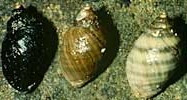
Muricidae is a large and varied taxonomic family of small to large predatory sea snails, marine gastropod mollusks, commonly known as murex snails or rock snails. With over 1,700 living species, the Muricidae represent almost 10% of the Neogastropoda. Additionally, 1,200 fossil species have been recognized. Numerous subfamilies are recognized, although experts disagree about the subfamily divisions and the definitions of the genera. Many muricids have unusual shells which are considered attractive by shell collectors and by interior designers.

The knobbed whelk is a species of very large predatory sea snail, or in the US, a whelk, a marine gastropod mollusk in the family Busyconidae, the busycon whelks.

Rapana venosa, common name the veined rapa whelk or Asian rapa whelk, is a species of large predatory sea snail, a marine gastropod mollusc or whelk, in the family Muricidae, the rock shells.

Urosalpinx is a genus of sea snails, marine gastropods in the subfamily Ocenebrinae of the murex snail family, Muricidae.

The eastern mudsnail, Ilyanassa obsoleta, is a species of sea snail, a marine gastropod mollusk in the family Nassariidae, the nassa mud snails.

The siphonal canal is an anatomical feature of the shells of certain groups of sea snails within the clade Neogastropoda. Some sea marine gastropods have a soft tubular anterior extension of the mantle called a siphon through which water is drawn into the mantle cavity and over the gill and which serves as a chemoreceptor to locate food. Siphonal canals allow for active transport of water to sensory organs inside the shell. Organisms without siphonal canals in their shells rely on passive or diffuse transport or water into their shell. Those with siphonal canals have a direct inhalant stream of water that interacts with sensory organs to detect concentration and direction of a stimulus, such as food or mates. In certain groups of carnivorous snails, where the siphon is particularly long, the structure of the shell has been modified in order to house and protect the soft structure of the siphon. Thus the siphonal canal is a semi-tubular extension of the aperture of the shell through which the siphon is extended when the animal is active.

Melongena corona, common name the Florida crown conch, is a species of sea snail, a marine gastropod mollusk in the family Melongenidae, the crown conches and their allies.
Gymnobela micraulax is a species of sea snail, a marine gastropod mollusk in the family Raphitomidae.

Cinctura hunteria, the northern banded tulip, is a species of sea snail, a marine gastropod mollusk in the family Fasciolariidae, the spindle snails, the tulip snails and their allies.

Domiporta gloriola, the glorious mitre, is a species of sea snail, a marine gastropod mollusc in the family Mitridae, the miters or miter snails.

Hexaplex fulvescens, the giant eastern murex or giant Atlantic murex or tawny murex, is a species of sea snail, a marine gastropod mollusk in the family Muricidae, the murex snails or rock snails.

Nucella emarginata, common name the emarginate dogwinkle, is a species of medium-sized predatory sea snail, a marine gastropod mollusk in the family Muricidae, the murex snails or rock snails.

Actinotrophon actinophorus is a species of sea snail, a marine gastropod mollusc in the family Muricidae, the murex snails or rock snails.

Stramonita biserialis is a species of sea snail, a marine gastropod mollusk in the family Muricidae, the murex snails or rock snails.
Urosalpinx cala is a species of sea snail, a marine gastropod mollusk in the family Muricidae, the murex snails or rock snails.
Ocenebra subangulata is a species of sea snail, a marine gastropod mollusk in the family Muricidae, the murex snails or rock snails.

Calyptraea chinensis, common name the Chinese hat snail or Chinese hat shell, is a species of small sea snail, a marine gastropod mollusk in the family Calyptraeidae, the slipper snails or slipper limpets, cup-and-saucer snails, and Chinese hat snails.

Lirabuccinum dirum, commonly known as the dire whelk, the spindle shell or the spindle whelk, is a species of sea snail, a marine gastropod mollusk in the family Tudiclidae, the true whelks.

Urosalpinx curtansata is an extinct species of sea snail, a marine gastropod mollusk in the family Muricidae, the murex snails or rock snails.
Urosalpinx macra is a species of sea snail, a marine gastropod mollusk in the family Muricidae, the murex snails or rock snails.
















